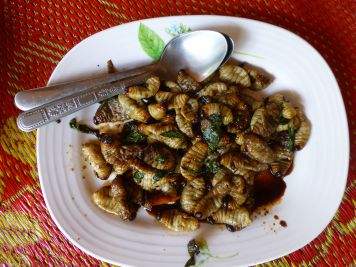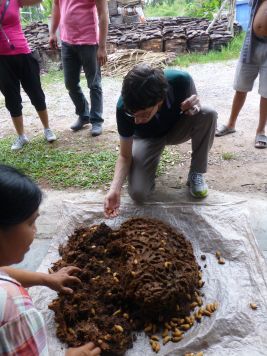
UC Riverside's Mark Hoddle helps Canadian research team win the Hult Prize
On Sept. 23, the Clinton Global Initiative awarded the Hult Prize, worth $1 million, to a team of student entrepreneurs at McGill University, Canada. Mark Hoddle, the director of the Center for Invasive Species Research at the University of California, Riverside, served as a consultant to the team whose goal was to combat hunger and nutrition deficiencies in impoverished regions by improving insect-based meals.
Hoddle, an extension specialist in entomology and an expert on both the red palm weevil and weevil farming in southeast Asia, traveled to Thailand Sept. 14-19 with a member of the winning team to assess red palm weevil farming practices.
“I did a whirlwind tour of the weevil farms with McGill University’s Gabriel Mott, an MBA student, and prepared a report and visuals from the trip for the package his team submitted for the Hult Prize,” Hoddle said. “On Sept. 23, I watched on the internet as the team pitched live in New York City in front a really big audience and an auspicious judging panel that included Nobel Peace Prize laureates, and guess what – the team won!”
A dish of cooked weevil larvae. Photo credit: Hoddle Lab, UC Riverside.
Entomophagy is the consumption of insects by humans for food — an ancient practice that tends to be concentrated in certain parts of the world, notably tropical and sub-tropical regions, where there is a diversity of large insects.
“Insects are excellent low cost sources of protein and essential nutrients,” Hoddle said. “Edible insects can often be sustainably harvested from wilderness areas and have very low carbon footprints if farmed for personal consumption or as a commercial enterprise.”
Due to interest in eating insects because of their nutritional and environmental benefits, and because a wide diversity of insects are eaten daily by millions of humans, there is interest in the viability of mass collection, production, or farming of certain species for food.
“This is already being done in some areas, with a notable example being the mass collection and subsequent preparation and sale of chapalines, a type of grasshopper, in Oaxaca, southern Mexico,” Hoddle said. “Another insect that has significant potential for mass production or farming are palm weevils. Larvae and pupae of these species are widely eaten in southeast Asia and farmed to a limited extent in some countries, notably Thailand.”
McGill University’s Gabriel Mott shops for red palm weevil larvae in Thailand. Photo credit: Hoddle Lab, UC Riverside.
More information is available on Hoddle’s blog.
Watch a 2012 video of Hoddle eating larvae.
Next, Hoddle plans to set up weevil farms in Ghana with the McGill team.
“They have a native palm weevil that is eaten but the larvae are not farmed,” he said.
There are three main ways red palm weevil larvae and pupae are prepared for eating: (1) stir-fried in a wok (very common), (2) prepared as a curry dish with vegetables, or (3) battered and deep fried. Sometimes live larvae may be eaten after floating in soy sauce. Cooked red palm weevil larvae and pupae provide a substantial and hearty meal either on their own or when supplemented with additional vegetables and rice or noodles.
Weevil larvae are very easy to farm, production costs are low, and profit margins are potentially high. Preparation of weevils, especially larvae, for cooking is straight-forward.
“Because larvae lack legs and antennae, it is easy to ‘disguise’ the fact that they are insects when prepared for consumption,” Hoddle said. “This is especially true when larvae are battered and deep fried. Cooking weevil larvae and pupae in creative ways, and perhaps developing a catchy marketing name, may enhance marketability and acceptance as a food, especially in areas where entomophagy is uncommon or insects are viewed as unclean and unsuitable for eating.”
In Thailand, Nittaya Ummarat, a post-graduate researcher at the UC Kearney Agricultural Research Center, helped translate Thai into English.


